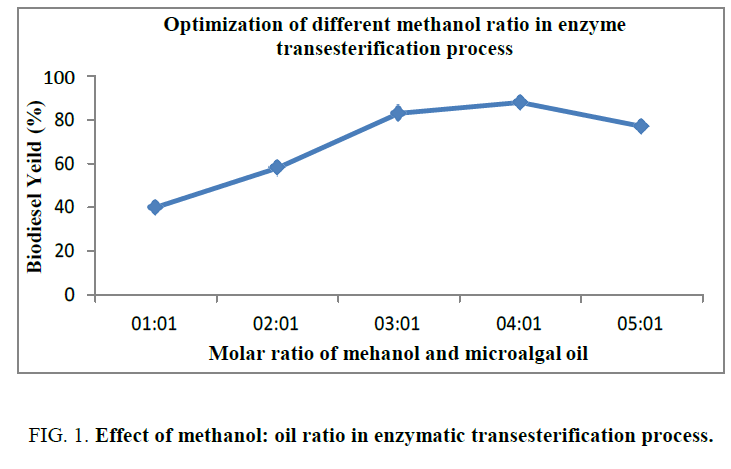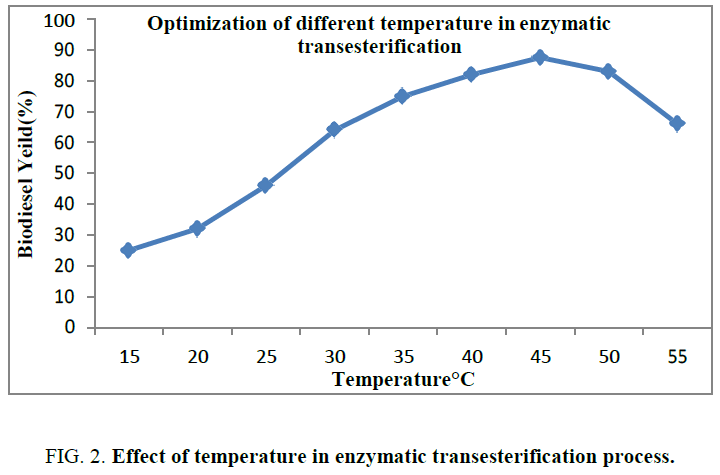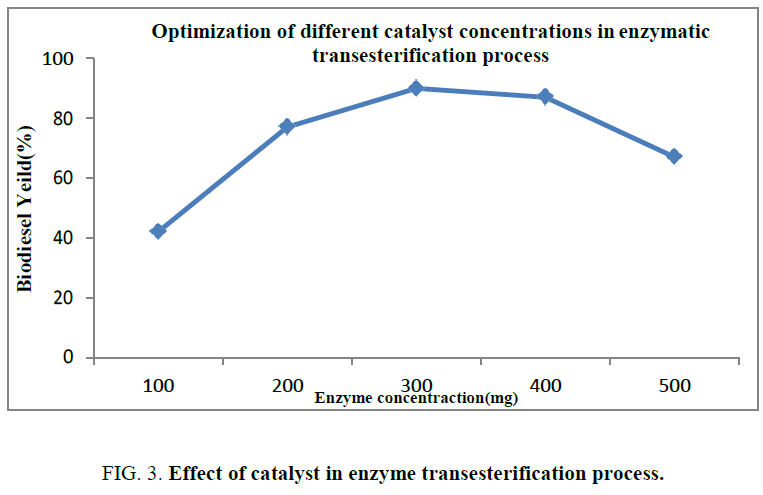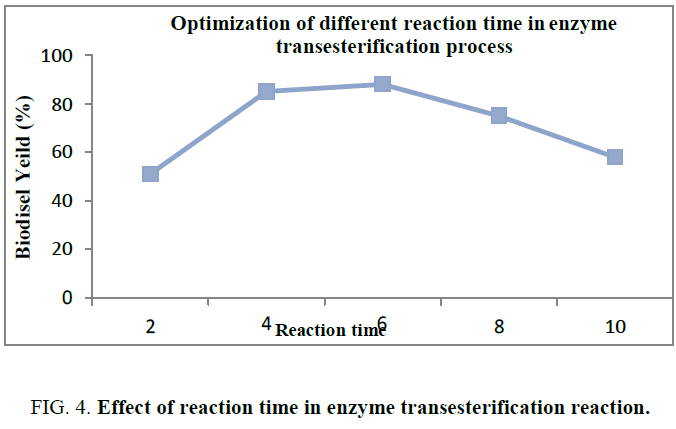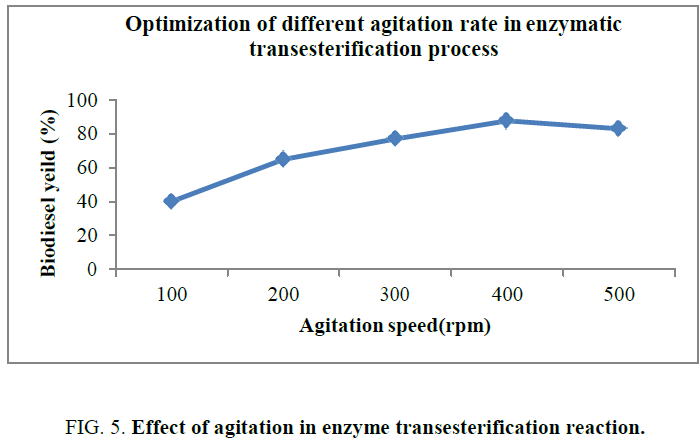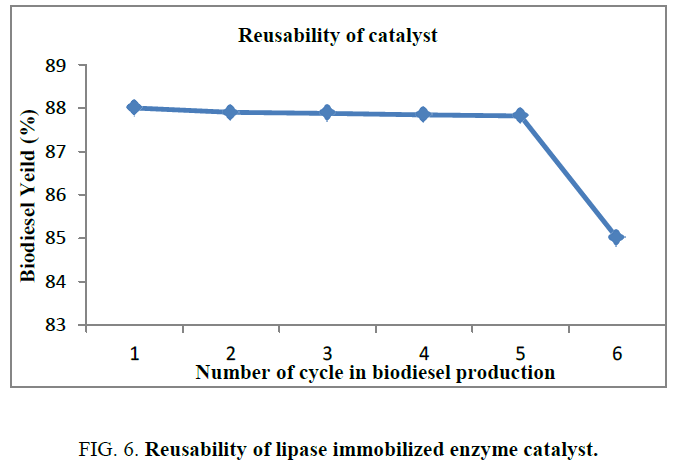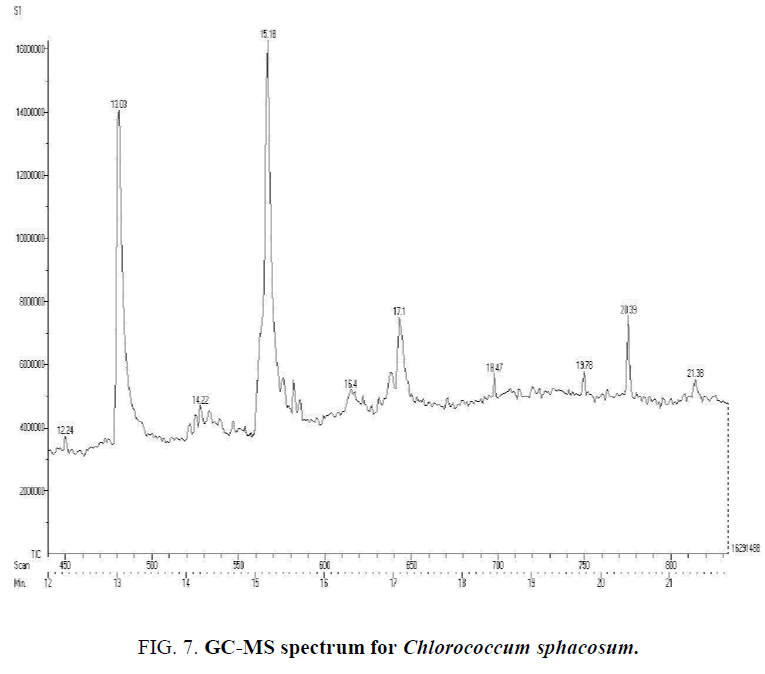Original Article
, Volume: 15( 3)Sustainable Biodiesel Production from a Newly Isolated Micro-Algal Species Chlorococcum Sphacosum Using a Novel Lipase Immobilised Functionalized Nanobiocataylst
- *Correspondence:
- Ranjitha J , CO2 Research and Green Technologies Centre, VIT University, Vellore, Tamilnadu, India, Tel: 9952223180; E-mail: ranjitha.j@vit.ac.in
Received: May 20, 2017; Accepted: July 03, 2017; Published: July 12, 2017
Citation: Micheal Donatus S, Vijayalakshmi S, Ranjitha J. Sustainable Biodiesel Production from a Newly Isolated Micro-Algal Species Chlorococcum Sphacosum Using a Novel Lipase Immobilised Functionalized Nanobiocataylst. Int J Chem Sci. 2017;15(3):157
Abstract
This research paper is mainly focused on the sustainable biodiesel production from a newly isolated micro-algal strain Chlorococcum sphacosum using a novel lipase immobilised functionalised nano-biocatalyst. In this reaction, the lipase was produced from Aspergillus niger (KP001169) a fungal strain isolated from oil contaminated soil sample collected nearby to the oil industry. The lipase was immobilized with magnetic nanoparticle using co-precipitation method and used as a nano-biocatalyst for the production of biodiesel production. The synthesized nano-biocatalyst enhanced the percentage yield of biodiesel. Using the lipase immobilised magnetic nanoparticles as a biocatalyst achieved maximum percentage yield 88% respectively. The catalyst can be reused more than five times in the biodiesel reaction without any treatment and activity changes and then after sixth cycle there is a loss in the activity of the synthesized nano-biocatalyst. Finally, the Fatty acid methyl esters (FAMEs) composition was characterized using GC-MS analytical technique.
Keywords
Biodiesel; Chlorococcum sphacosum; Lipase immobilised Fe3O4 nanoparticles; FAME
Introduction
Due to the rapid increase in the world population, need for fossil fuels are to be increased. Because of its several disadvantages, the production of fossil fuels was limited. Recently the researchers and scientists had started giving more attention towards developing a new alternative source for fuels. Now-a-days much attention has been paid towards biodiesel production from different raw materials, such as vegetable oil, sunflower oil, palm oil, rapeseed oil, and waste cooking oil, etc., [1-3]. The cost of biodiesel is mainly based on the raw materials and the other process involved in biofuel production. The present situation in the cost of biofuels is two-fold that of commercial diesel, due to the 60%-70% of the total amount was spent to buy the raw materials. Hence, to find out the alternative oil sources for biodiesel synthesis is the third-generation feedstock i.e., the oleaginous microalgae [4]. Biodiesel has several merits compared to the diesel; it has easy way transportability, high combustion efficiency, low sulphur and aromatic content, high cetane number and biodegradability, less GHG emission, etc., The demerits of biodiesel are high viscosity, lower energy content, high cloud and pour point, high nitrogen oxide emission, lower engine speed and power, injector cooking, high price and engine erosion, etc., [5]. Simultaneously, the major factors affecting transesterification process is the molar ratio of alcohol, catalyst, temperature, time and agitation speed, etc., Currently the production of biodiesel was carried out in the presence of corrosive chemical catalysts (strong acids or bases) and led to less product yield [6]. Recently, lipase immobilized nanoparticles play an important role in the transesterification process. The main demerits of chemical process such as high energy input, elimination of salt, difficulty in recycling glycerol, soap formation, etc., [7,8]. To overcome these issues, enzymatic transesterification is used as an alternative process for the biodiesel production. In this process, the by-product glycerol can be easily recovered, salt and catalyst can be avoided during this reaction. Enzymatic transesterification process produces high yield under milder conditions compared to the other reaction method [9]. Lipase-catalyzed transesterification takes place in two steps, which involves hydrolysis of the ester bond and esterification with the second substrate. Lipase enzyme is an alternative catalyst for biodiesel production and eco-friendly [10-12]. The immobilized lipases are stable at temperature and also used as reusable catalyst. The reusability of lipases solves the high cost of the enzymes and makes them as a suitable catalyst for biodiesel production in industrial scale.
Materials and Methods
Chemicals
All the media components were purchased from Hi-media. Chemicals and reagents, including olive oil used, were purchased from Sigma-Aldrich (India), were of analytical grade, and were used without further purification. Aspergillus niger (KP001169) was isolated from oil contaminated soil and used for further studies.
Optimization of different methanol ratio in enzyme transesterification process
The enzymatic transesterification reaction was carried out in a round bottom flask containing the reaction mixture of micro- algal oil and 300 mg of lipase immobilized MNPs. The molar ratio of methanol and algal oil was optimized from the range of 1:1, 1:2, 1:3, 1:4, 1:5 and 1:6. The reaction mixture was placed in a magnetic stirrer maintaining at a temperature of 45°C and 400 rpm respectively for about 6 h. The biodiesel conversion efficiency was calculated and expressed by using empirical formula stated as; weight of FAMEs divided by weight of oil content.
Optimization of different temperature in enzyme transesterification process
To optimize the reaction temperature, the reaction takes place at constant molar ratio 1:4 (oil/methanol) by varying reaction temperature at 400 rpm respectively for about 6 h. The effect of temperature was studied at various ranges from 15°C-55°C. Optimization of different enzyme concentrations was seen in enzymatic transesterification process.
The enzymatic transesterification was carried out by adding the lipase immobilized magnetic nanoparticles at different concentrations of 100, 200, 300, 400 and 500 mg. The reaction takes place at constant molar ratio 1:4(oil/methanol) by varying the concentrations of nano-biocatalyst at 400 rpm respectively for about 6 h.
Optimization of different shaking speed in enzyme transesterification process
The reaction mixture consists of 300 mg lipase immobilized magnetic nanoparticles, constant molar ratio 1:4 (oil/methanol) by varying the reaction rpm from 100, 200, 300, 400 and 500 respectively for about 6 h.
Optimization of different reaction time in enzymatic transesterification process
The reaction mixture consists of 300 mg lipase immobilized magnetic nanoparticles, constant molar ratio 1:4 (oil/methanol) by varying the reaction time from 2, 4, 6, 8 and 10 respectively.
Production of biodiesel by optimized factors using the transesterification process
The enzymatic transesterification reaction was carried out using the optimized parameters. The reaction mixture consists of crude oil and methanol ratio (1:4) and the catalysts concentration is 300 mg lipase immobilized magnetic nanoparticles and mixed with hexane 100 mL to the reaction mixture. The reaction mixture was placed in a magnetic stirrer maintaining at a temperature of 45°C and 400 rpm respectively for about 6 h. The biodiesel conversion efficiency was calculated and expressed by weight of FAMEs divided by weight of oil content.

Reusability of immobilized lipase enzyme in enzymatic transesterification process
The reusability of the prepared enzyme catalyst was estimated by using the catalyst repeatedly to perform transesterification process at the same reaction condition to estimate the percentage yield of biodiesel in each cycle. After each enzymatic transesterification process, lipase immobilized magnetic nanoparticles was removed by magnet and washed twice with hexane and ultrapure water to remove any foreign substance.
Biodiesel characterization of Chlorococcum sphacosum
The fatty acid methyl ester composition of the biodiesel produced from Chlorococcum sphacosum, was analyzed by using GC-MS analytical technique. Similarly, the fuel properties of biodiesel from Chlorococcum sphacosum were estimated using the standard ASTM protocol. The following factors were analyzed for the produced bio-diesel such as density, viscosity, specific gravity, flash point, pour point, cloud point, acid value, iodine value, saponification value, ash content and water content, etc., and the results were compared with ASTM D0975, ASTM D6751 and EN 14214.
Results and Discussion
Effect of methanol: Oil ratio in enzyme transesterification reaction
The role of methanol: oil ratio in the production of biodiesel was optimised under transesterification reaction conditions; methanol: microalgae oil (4:1), 300 mg of lipase immobilised MNPs at a temperature of 45°C, 400 rpm respectively for about 6 h. The maximum biodiesel yield achieved was 87.6%, when the molar ratio is very close to 4:1. However, beyond the molar ratio of 5:1, the excessively added methanol has no significant effect on the production of biodiesel yield shown in the FIG. 1. El-Batal et al. [13] reported that lipase isolated from Aspergillus niger were coated with barium ferrite magnetic nanoparticles and achieved maximum yield as 90% with a molar ration of 4:1. The increase of methanol concentrations will affect the FAME conversion. Similarly, Jyothi ramalingam and Wang et al. [14] reported that the high methanol concentration that inhibits the activity of lipase enzyme during the conversion of the FAME in the biodiesel production.
Effect of temperature in enzyme transesterification reaction
The temperature plays an important role in the enzymatic biodiesel process. To study the effect of temperature on FAME conversion in the enzymatic biodiesel process, the range of temperature in this process were studied in between 15°C-55°C with an interval of 5°C, at constant rpm of 400 respectively for about 6 h. In this study, FAME conversion increases up to temperature 45°C and achieved maximum biodiesel yield as 88%. After increasing the reaction temperature also there is no significant increase in the FAME conversion, because it affects the enzyme activity by denaturing the protein due to higher temperature as shown in the FIG. 2. Tran et al. [15] reported that FAME conversion production of biodiesel was decreased, when the temperature was increased to 50°C for C. vulgaris ESP-31 by enzymatic transesterification.
Effect of various catalyst concentrations in enzyme transesterification reaction
The role of catalyst was investigated in enzyme transesterification reaction at constant temperature 45°C and 400 rpm for about 6 h. It was found that in 300 mg of catalyst resulted in maximum biodiesel yield as 87.6%. The amount of catalyst plays an important role in enzymatic transesterification and verified with different amount of catalyst ranges from 100 mg- 500 mg as shown in the FIG. 3. At low enzyme concentration 100 mg, the transesterification process was incomplete and resulted in a low biodiesel yield 42% and then increasing the concentration of catalyst does not play any significant increase in the yield. Kumari et al. [16] Maceiras et al. [17] and Jegannathan et al. [18] reported that the higher concentration of biocatalyst affected the active site of the substrates and so the aggregation of enzyme will occur as a result of this decrease in the biodiesel production yield. The superfluous enzyme will reduce the activity of lipase and decrease the percentage yield of biodiesel production [19].
Effect of reaction time in enzyme transesterification reaction
The enzymatic transesterification reaction takes place at a constant temperature, rpm, and catalyst concentration by varying the reaction time. The effect of reaction time in biodiesel production studies was carried out by changing the reaction time from 2 h-10 h. The optimized reaction time is 6 h for the conversion of microalgae oil in to FAME by using lipase immobilized biocatalyst achieved maximum yield was 88% as shown in the FIG. 4 . Based on the results, if the reaction was carried out by increasing the reaction time does not show any significant increase the biodiesel yield [20]. If the reaction time is increased it will inhibit the lipase activity by methanol and glycerol after certain period of time [21].
Effect of agitation in enzyme transesterification reaction
In enzymatic transesterification reaction, agitation is one of the most important parameters. Kumari et al. [16] reported that the immobilization reaction takes place properly only if the agitation is properly optimised. The reactants need to diffuse from the bulk liquid to the external surface of the particle and then into the interior pores of the catalyst. To study the effect of agitation on the biodiesel production, the reaction was conducted in between 100 rpm-500 rpm with an interval of 100 rpm as shown in the FIG. 5. The maximum percentage yield of biodiesel was found to be 87.6% at 400 rpm. Li and Yan [19]; Ognjanovic et al. [22]; Tran et al. [15] reported that the agitation also enhances the rate of reaction, they play an important role in the mass transfer resistance between oil and methanol and then immobilizes lipase at the catalyzing interface, finally enhancing the reaction rate. On the other hand, when the speed reaches beyond 500 rpm, the biodiesel percentage yield was also decreased. This is due to the damage of the immobilized beads, leads to the inactivation of lipase by mechanical agitation process.
Reusability of immobilized enzyme catalyst in transesterification process
The main advantage of lipase immobilized catalyst is its reusability. Gharat and Rathod [9] reported that catalyst reusability was important parameter to decide the possibilities of industrial-scale enzymatic biodiesel production. The present investigation is mainly based on the stability and reusability of immobilized lipase from Aspergillus niger. There was no significant loss of lipase activity even after immobilized enzyme catalyst was used for five cycles as shown in the FIG. 6 . The previous study clearly reported that lipase immobilized magnetic nanoparticles was used for about six cycles without any loss in the biodiesel percentage yield [15]. Likewise, Batal et al. [23] investigated the activity of immobilized lipase on magnetic nanoparticles and it was found that at sixth cycle without any negative impact on the biodiesel production yield. The gradual enzyme loss was observed only at seventh cycle, because of the leakage of lipase from the support due to the washing of biocatalyst. It was stated that the conformational change of lipase and inhibition of lipase by methanol during the methanolysis reaction may be the reasons for enzyme activity loss when repeatedly used [24]. The reusability of enzyme helps in cut down the purification cost of the methyl esters and enzyme cost [25].
Characterization of biodiesel using GC-MS spectral analysis
The biodiesel was produced by using the optimized physical and chemical parameters in enzymatic transesterification reaction. The FAME obtained was characterized by using gas chromatography as shown in the FIG. 7 and TABLE 1. Based on the GC-MS results, saturated and unsaturated fatty acids which are required for the biodiesel were identified.
| S.No | Retention time | Fatty acids |
|---|---|---|
| 1 | 12.24 | Nonadecanoic methyl ester |
| 2 | 13.03 | 7,10-Hexadecanoic methyl ester |
| 3 | 14.22 | Eicosanoic methyl ester |
| 4 | 15.18 | n-Hexadecanoic methyl ester |
| 5 | 17.1 | 9-Octadecanoic methyl ester |
| 6 | 18.47 | Tetradecanoic methyl ester |
| 7 | 19.78 | Heptadecanoic methyl ester |
| 8 | 20.39 | Pentadecanoic methyl ester |
TABLE 1. Fatty acid profile of Chlorococcum sphacosum by GC-MS.
Physcio-chemical properties of biodiesel
The results showed that the properties of produced biodiesel were compared with the diesel standard as shown in the TABLE 2. Based on the results, the low viscosity of the produced biodiesel indicates that it can be directly used in existing engines and also the heating value slightly lower, due to the high percentage of oxygen content of the produced biodiesel, which is not present in the conventional diesel. The present of the oxygen content in the produced biodiesel may help to achieve the complete combustion. In biodiesel production, the flash point is higher and it is safer for storage and transportation. The cetane number of the biodiesel was found as 57.6 which help in good cold start behavior and a smooth run of the engine. If the fuel has low cetane number it leads to the increase in the exhaust emission because of incomplete combustion. Cetane number is a relative measure of the delay time between injection and auto-ignition of fuels [26]. In earlier report, it was suggested that the viscosity affects the atomization quality, size of drop and penetration. The problem of high viscosity fuel is poor combustion, increased exhaust smoke and emissions. Also, it leads to the formation of large fuel drops during injection which may cause poor fuel atomization during the spray, increases the engine deposits, needs more energy to pump the fuel, and wears fuel pump elements and injectors. Density affects the air-fuel ratio and amount of biodiesel injected into the combustion chamber. The cloud point indicates the cold flow properties of biodiesel and also too high unsaturation leads in oxidation problem and so stabilizer should be added to extend the storage life of biodiesel [27]. The flash point, pour point and cloud point of the produced biodiesel was found as 155°C, -12°C and 7°C respectively.
| Properties | Biodiesel | ASTM D0975 | ASTM D6751 | EN 14214 |
|---|---|---|---|---|
| Density at 30°C g/cm3 | 0.863 | 0.876 | 0.875-0.90 | 0.86 to 0.90 |
| Viscosity at 40°C mm2/sec | 3.421 | 1.9 to 4.1 | 1.6 to 6 | 3.5 to 5 |
| Specific gravity | 0.819 | 0.850 | 0.88 | --- |
| Flash point °C | 115 | 60-80 | 100 to 170 | >120 |
| Pour point °C | -12 | -35 to -15 | -15 to 16 | --- |
| Cloud point °C | 7 | -15 to 5 | -3 to 12 | --- |
| Cetane number | 57.6 | 40 to 55 | 47 to 65 | --- |
| Acid value mg KOH/g | 0.23 | 0.35 | <0.8 | <0.5 |
| Iodine value I2/g | 87.9 | --- | --- | <120 |
| Ash content % | NIL | 0.01 | <0.02 | <0.02 |
| Water content % | NIL | 0.02 | 0.03 | <0.05 |
TABLE 2. Physcio-chemical properties of biodiesel.
Conclusion
The present research work is mainly focused on the low-cost biodiesel production from the newly isolated micro-algal species from the agro-industrial waste water. The isolated algal strain contains high lipid content and then optimized process parameters by using physical and chemical properties to increase the biodiesel production yield. The main merit of the research work is low-cost cheap catalyst lipase immobilized magnetic nanoparticles. The catalyst immobilization addresses several issues: repetitive and continuous use, localization of the interaction, prevention of product contamination, reduction of effluent problems and material handling, and effective control of the reaction parameters. In this study, we have synthesized a novel catalyst for the production of biodiesel and achieved high percentage yield in FAME conversion. Similarly, on the other hand, we had analyzed physical and chemical properties of the produced biodiesel and compared with diesel ASTM and EN standards. In near future, the produced biodiesel can be used as a green fuel in diesel engine.
References
- Mekhilef S, Saidur R. A review on palm oil biodiesel as a source of renewable fuel. Renew Sustainable Energy Rev. 2011;15:1937-49.
- Georgogianni KG, Katsoulidis AK, Pomonis PJ, et al. Transesterification of rapeseed oil for the production of biodiesel using homogeneous and heterogeneous catalysis. Fuel Process Technol. 2009;90:1016-22.
- Zhang Y, Dubé MA, McLean DD, et al. Biodiesel production from waste cooking oil: 1. Process design and technological assessment. Bioresour Technol. 2003;89:1-69.
- Chisti Y. Biodiesel from microalgae. Biotechnol Adv. 2007;25:294-306.
- Demirbas A. Biodiesel from vegetable oils via transesterification in supercritical methanol. Energy Convers Manage. 2002;43:2349-56.
- Moser BR. Biodiesel production, properties and feed stocks. In: Tomes D, Lakshmanan P, Sonstad D, editors, Biofuels. New York, Springer. 2011;pp:285-347.
- Rodriques RC, Zachia Ayub MA. Effects of the combined use of thermomyces lanuginosus and rhizomucor miehei lipases for the transesterification and hydrolysis of soybean oil. Process Biochem. 2011;46:682-8.
- Yoshida A, Hama S, Tamadani N, et al. Continuous production of biodiesel using whole-cell biocatalysts: Sequential conversion of an aqueous oil emulsion into anhydrous product. Biochem Eng J. 2012;68:7-11.
- Gharat N, Rathod VK. Ultrasound assisted enzyme catalyzed transesterification of waste cooking oil with dimethyl carbonate. Ultrason Sonochem. 2013;20:900-5.
- Kim J, Jia J, Wang P. Challenges in biocatalysis for enzyme based biofuel cells. Biotechnol Adv. 2006;24:296-308.
- Bisen PS, Sanodiya BS, Thakur GS, et al. Biodiesel production with special emphasis on lipase-catalyzed transesterification. Biotechnol Lett. 2010;32:1019-30.
- Verma ML, Barrow CJ, Puri M. Nanobiotechnology as a novel paradigm for enzyme immobilization and stabilization with potential applications in biodiesel production. Appl Microbiol Biotechnol. 2013;97:23-39.
- El-Batal AI, Ayman A, Mohamed A, et al. Biodiesel production by Aspergillus niger lipase immobilized on barium ferrite magnetic nanoparticle. Bioengineering. 2016;pp:1-14.
- Jyothi RR, Wang MK. Review of recent developments in solid acid, base, and enzyme catalysts (heterogeneous) for biodiesel production via transesterification. Ind Eng Chem Res. 2009;48:6162-72.
- Tran DT, Chen CL, Chang JS. Effect of solvents and oil content on direct transesterification of wet oil bearing microalgal biomass of Chlorella vulgaris ESP-31 for biodiesel synthesis using immobilized lipase as the biocatalyst. Bioresour Technol. 2012;135:pp:213-21.
- Kumari A, Mahapatra P, Kumar Garlapati V, et al. Enzymatic transesterification of Jatropha oil. Biotechnol Biofuels. 2009;2:1-5.
- Maceiras R, Vega M, Costa C, et al. Effect of methanol content on enzymatic production of biodiesel from waste frying oil. Fuel. 2012;88:2130-4.
- Jegannathan KR, Yee LJ, Chan ES, et al. Production of biodiesel from palm oil using liquid core lipase encapsulated in k-carrageenan. Fuel. 2010;89:2272-7.
- Li Q, Yan Y. Production of biodiesel catalyzed by immobilized Pseudomonas cepacia lipase from Sapiumse biferum oil in micro-aqueous phase. Appl Energy. 2010;87:3148-54.
- Dennis YCL, Wu X, Leung MKH. A review on biodiesel production using catalyzed transesterification.App Ener. 2010;87:1083-95.
- Fukuda H, Konda A, Noda N. Biodiesel fuel production by transesterification of oils. J Biosci Bioeng. 2011;92(5):405-16.
- Ognjanovic N, Bezbradica D, Jugovic ZK. Enzymatic conversion of sunflower oil to biodiesel in a solvent-free system: Process optimization and the immobilized system stability. Bioresour Technol. 2009;100(21):5146-54.
- Batal AIE, Farrag AA, Elsayed MA, et al. Biodiesel production by Aspergillus niger lipase immobilized on barium ferrite magnetic nanoparticles. Bioengineering. 2016;3:1-15.
- Xie W, Wang J. Immobilized lipase on magnetic chitosan microspheres for transesterification of soybean oil. Biomass and Bioenergy. 2012;36:373-80.
- Fukuda H, Hama S, Tamalampudi S, et al. Lipase localization in Rhizopusoryzae cells immobilized within biomass support particles for use as whole-cell biocatalysts in biodiesel-fuel production. J Bio Sci Bioeng. 2006;101(4):328-333.
- Verduzco LFR, Rodríguez JER, Jacob ADRJ. Predicting cetane number, kinematic viscosity, density and higher heating value of biodiesel from its fatty acid methyl ester composition. Fuel. 2012;91:102-11.
- Johnson MB, Wen Z. Production of biodiesel fuel from the microalga schizochytrium limacinum by direct transesterification of algal biomass. Energy Fuels. 2009;23:5179-83.
